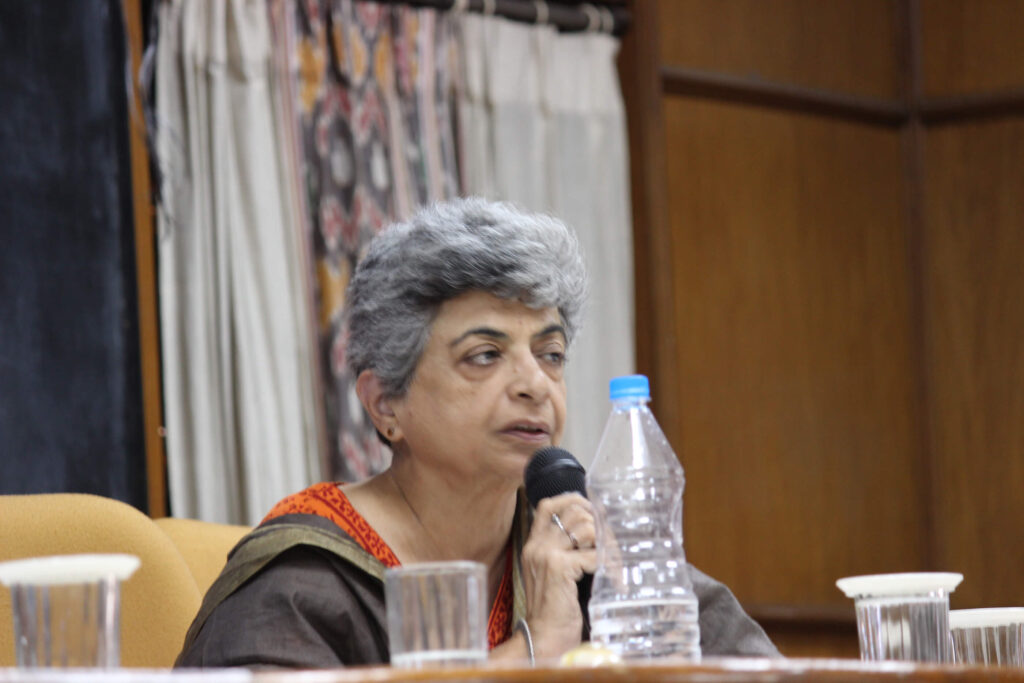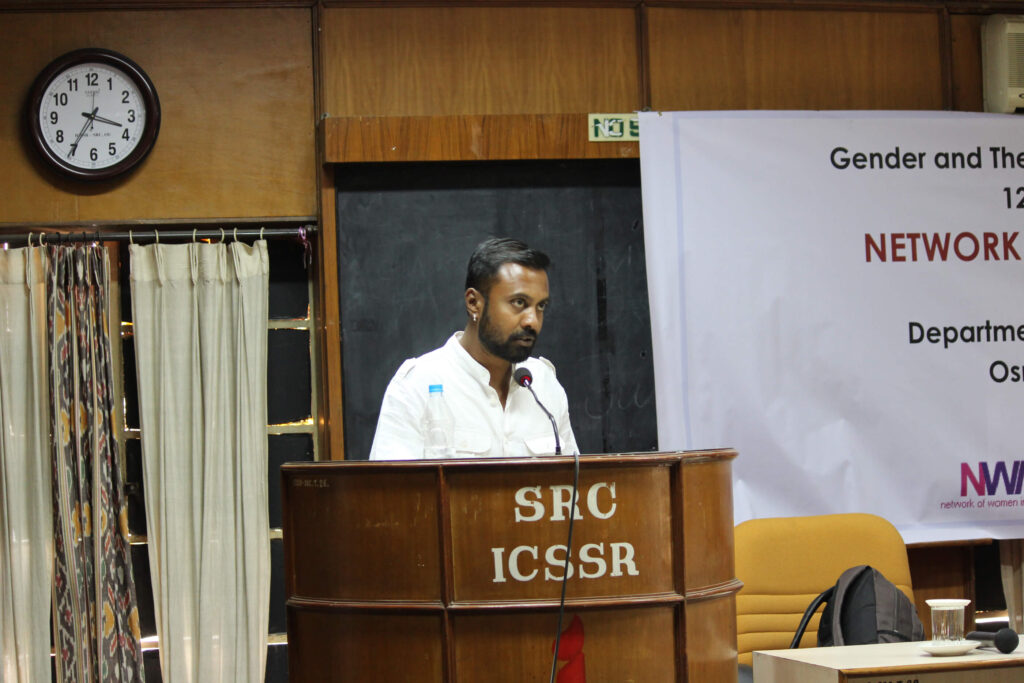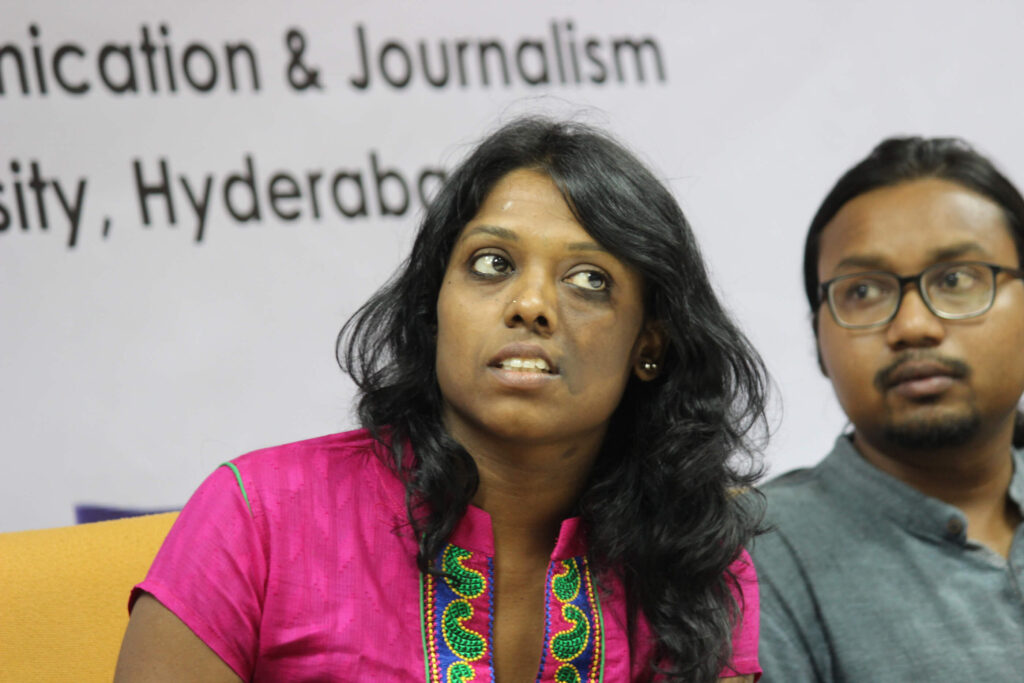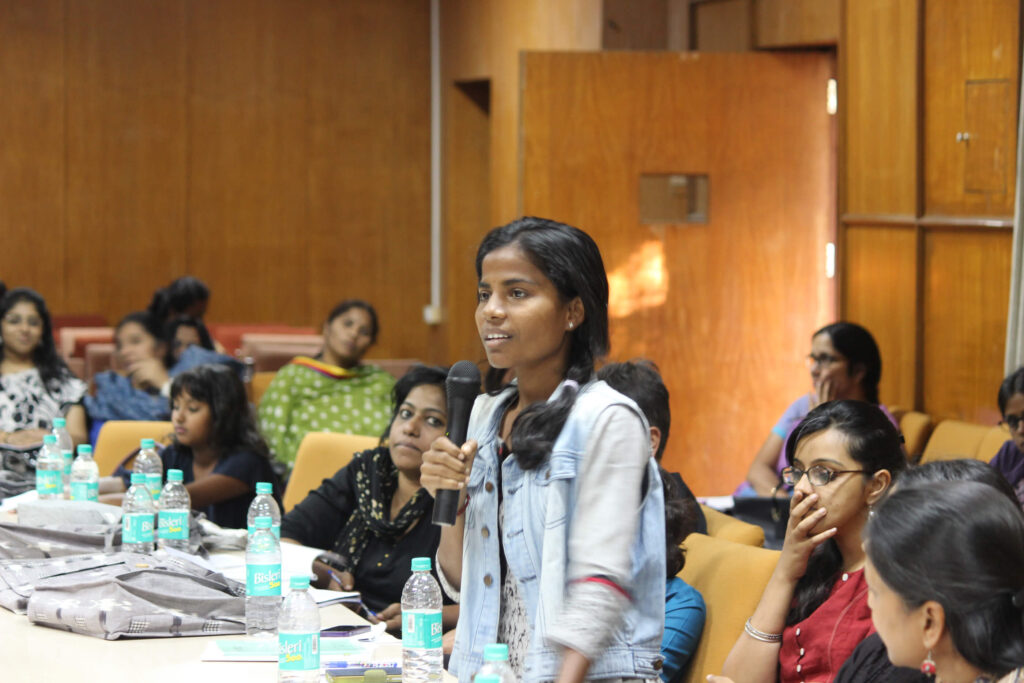Friday, 11 November 2016, 3.00-4.30 pm
Working Session 1: Towards Inclusive Newsrooms
As the chair of the session, Hindustan Times correspondent Sudipto Mondal, was held up in traffic, network member Raksha Kumar stepped in to initiate the proceedings.
Mumbai-based independent journalist and network member Jyoti Punwani addressed the relationship between the ‘mainstream’ media and minority communities, particularly Muslims. Jyoti, who has been consistently covering issues related to communalism and minority rights, quipped that she hadn’t set foot in a newsroom for 26 years. Yet, she said, things have not changed much in terms of the perpetuation of stereotypes and the manner in which Muslims are covered, be it during times of conflict or in ‘peace’ time. When riots or bomb blasts take place, there is heavy reliance on police handouts.

Questioning the police version would inevitably mean crime reporters get cut off from police sources. “Should not editors then ask other reporters to check the veracity of police claims, especially since the police have, more often than not, been found to have framed innocents, and are known to be anti-Muslim?” she asked. Instead, she pointed out, the English press turns many of these policemen into heroes.
Jyoti also described how the use of language and photographs and the placement of news betray prejudice. For example, the Babri Masjid gradually began to be called the ‘disputed structure’, lending legitimacy to the Ram Janmabhoomi movement which aimed to demolish the Masjid and replace it with a temple. Likewise, ‘love jihad’, a concept created by Hindutva extremists intolerant of inter-religious marriage, is often used without quotation marks. The myth of ‘Modi the moderate’ was another example of reporting belying reality. In a recent case, the English press continued to describe individuals as ‘main accused’ even after they had been acquitted, she said.
There is also a different emphasis on the placement of news related to the majority and minority communities, she argued. For example, news stories about Muslims even suspected of terror are always placed on the front page, while reports of Hindus actually caught making bombs have been buried inside. The former are often described as ‘terror techies’, while even those Hindutva activists convicted of having perpetrated acts of terror have been described merely as ‘right-wing extremists’.
The question the English press must ask is: what would be the reaction of Muslim readers to such coverage?
Analysing the use of images, Jyoti pointed out that file photographs of women in stereotypical garments like burqas are used in any article on issues related to Muslims, presenting a skewed version of reality. For example, coverage of the demonstrations urging the implementation of the Srikrishna Commission report on the 1992-93 riots in Mumbai included photos only of burqa-clad women, ignoring the fact that many non-Muslims also took part in them. This sent out the wrong message that the demand was purely from Muslims.
All this has resulted in loss of credibility for the English press among Muslims, aggravated by the vastly different standpoint from which the Urdu press reports the same incidents. However, she clarified, the Urdu press is even more non-inclusive, since its readership is confined to Muslims.
The increasing presence in English newspapers of Muslim reporters with strong roots in their community has started changing the way the community is represented, said Jyoti. Editors of the English press are largely liberal, but how does one change the mindset of the majority of journalists, be they reporters or sub-editors who are responsible for the placement of news, headlines, etc.?
Jyoti also pointed out that this was not a problem concerning only Muslims. During the Punjab turmoil in the 1980s, Sikhs were similarly labelled by the English press.
Introducing the issue of the invisibility of a large section of society, Sudipto Mondal said that, although Dalits are not a minority in India, he had met only about seven Dalit journalists, and not a single Dalit or Adivasi among the top decision makers or owners of the ‘mainstream’ Indian media. In contrast to American newsroom editors who, as far back as in 1978, passed a resolution to increase newsroom diversity, Indian newsrooms remain not only predominantly upper caste but devoid of any move towards diversity, especially in terms of caste.

Jeyarani, Lifestyle Editor at Dinamalar in Chennai, delivered a passionate speech translated by journalist colleague and network member Kavitha Muralidharan. She first transported us to a fantasy land where a law is enacted ordering all media houses in the country to prioritise and publish/telecast only caste-related atrocities: “The media houses will be forced to expose a caste atrocity every second… If there is such a law, as we are now imagining, breaking news would become the norm of the day!” But in the real world there is a blanking out of caste atrocities. This is because, as Jeyarani explained, “Just like in society, where we have rigid caste hierarchies, the media and journalists, too, operate on the basis of caste hierarchies. The fourth pillar of democracy has come crumbling down under the pressure of caste hierarchies when it should have stood upright holding the torch of justice.”

Dalit journalists, most of them first generation graduates, invariably end up in regional language media. According to Jeyarani, they generally do not make it in the English media because they lack the ‘desired colour’ as well as proficiency in English. Vernacular media accommodates them but does not consider them on par with journalists from other communities when it comes to promotions or salary hikes. “We have only two options: to shrink ourselves to fit the space media offers us or to leave the media altogether.”
Commenting on identity politics, Jeyarani said, “If and when a Dalit journalist writes on Dalit issues or even speaks about them, their colleagues call it caste affinity or caste pride. How can a Dalit feel proud about her or his caste? The effort of Dalit journalists to record the violence against Dalits is only an expression of their anti-caste emotion, not an attempt to promote their own caste. But my Dalit colleagues, aware of such baseless criticisms, would not show the same interest in a caste issue as they would in a political issue. Several of them have had to even conceal their identity and live with it. It is shameful that media houses have still not created a free and fair atmosphere where Dalits can work without any kind of inhibition.”
Jeyarani drew attention to a tragedy ignored by the mainstream English media: the story of a Dalit youth, Ayyaru, who committed suicide in February this year, unable to bear caste discrimination. Like Rohit Vemula, he also left a moving suicide note. However, the letter in Tamil did not create even one percent of the impact that Rohit’s letter in English did. She asked poignantly, “How qualified should Dalits be to seek the attention of the media? Why isn’t the media concerned about Ayyaru – as it was about Rohit – if it opposes caste-related deaths? On the day we begin reading Ayyaru’s letters, on the day we begin demanding justice for Ayyaru’s death, on the day we oppose violations by people like us, we can be sure that the media is actually changing.” She ended with an exhortation to journalists to become casteless and work against caste: “We should work on strategies that would bring more news on Dalit issues into our newsrooms. The workplace should offer them dignity and respect.”
Akash Poyam, who runs the website Adivasi Resurgence out of Hyderabad, talked about the absence of the Adivasi voice in ‘mainstream’ media. According to him, coverage of Adivasi issues is largely confined to victim narratives about atrocities, and romanticised perspectives such as that of the educational institutions called ghotuls which are commonly depicted as places where teenage Adivasis have free sex. Akash pointed out that the victim narrative was not empowering, and terms like ‘primitive’ further marginalised them.
The media need to cover the ordinary realities of Adivasi lives, and not highlight only extraordinary or celebratory aspects of their societies. The polarised view of Adivasi lives between victimhood and exoticisation missed a layered understanding of the complexities of their lives, he said. For example, an analysis of why there are fewer jatras (festivals) in Adivasi areas in Chhattisgarh must be linked to mass killings by security forces during such events. While buying into the State-versus-Maoist template, the media often fails to report on the effects of military operations on ordinary people. He linked the lack of grounded, nuanced coverage of Adivasi issues to the absence of Adivasis in the newsroom. He recommended affirmative action to draw more Adivasi journalists into media organisations.
Jayanti Buruda, a young journalist from Malkangiri, Odisha, jumped into the discussion with her inspiring example. She related how she was the first Adivasi graduate in Malkangiri, but she received scant respect, whether as a woman or as an Adivasi. She said she was keen to do stories highlighting the issues faced by Adivasis in her area: child deaths, malnutrition, lack of health services.

Participants reflected on the question of how to cover ‘marginalised communities’ more sensitively, and what could be done on a practical basis to promote more and better coverage of issues concerning them. The use of terminology such as ‘higher’ and ‘lower’ caste was questioned as possibly reinforcing caste hierarchies. It was suggested that a better alternative would be to promote the term ‘lowered’ caste instead, to stress the deliberate exclusion of certain castes. The session ended with the suggestion that – in addition to the ‘gender lens’ that many in the network have been advocating – it was necessary to develop and use a lens that enables a more sensitive and nuanced look at events and issues concerning Dalits, Adivasis, disadvantaged minorities, and the poor in general, and that facilitates the inclusion of their voices in the media.


